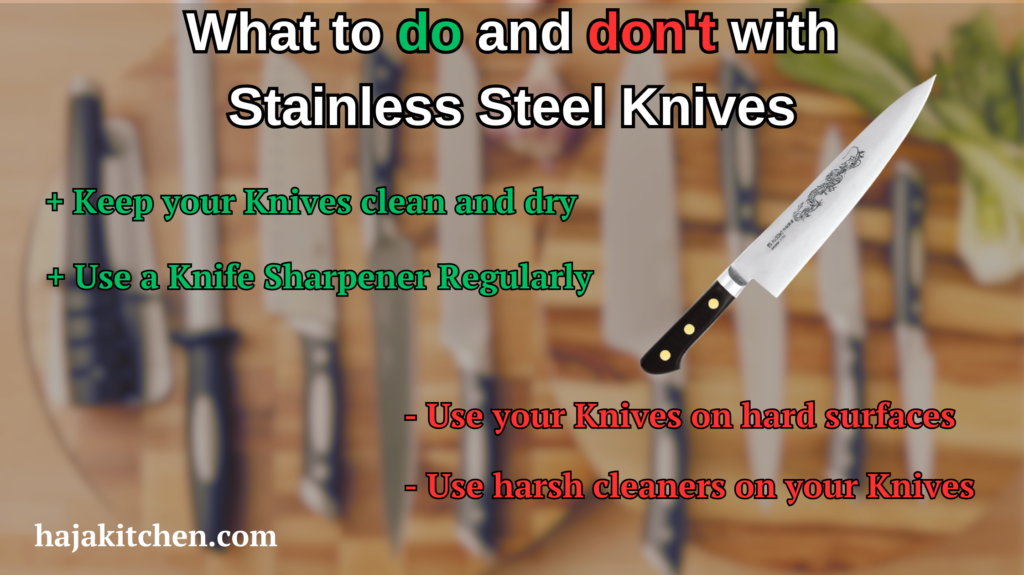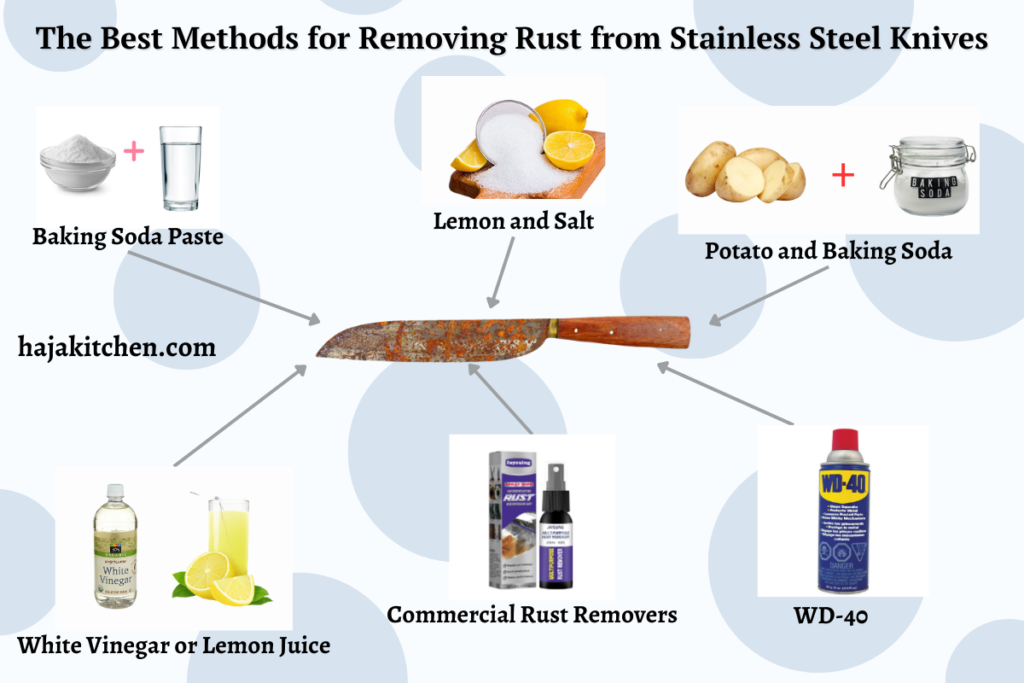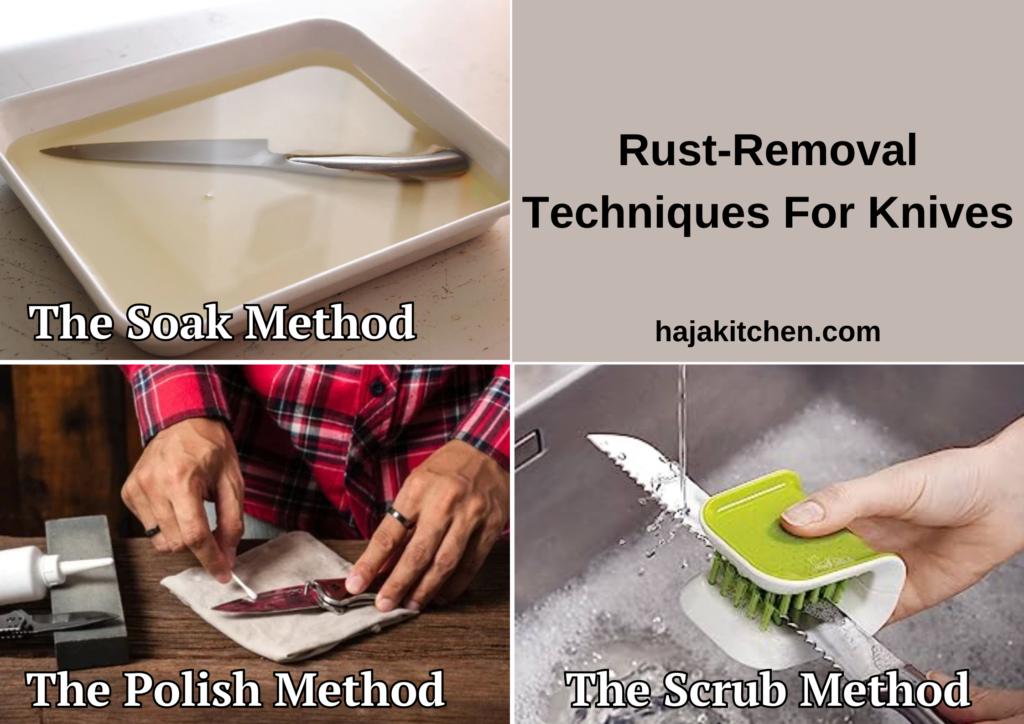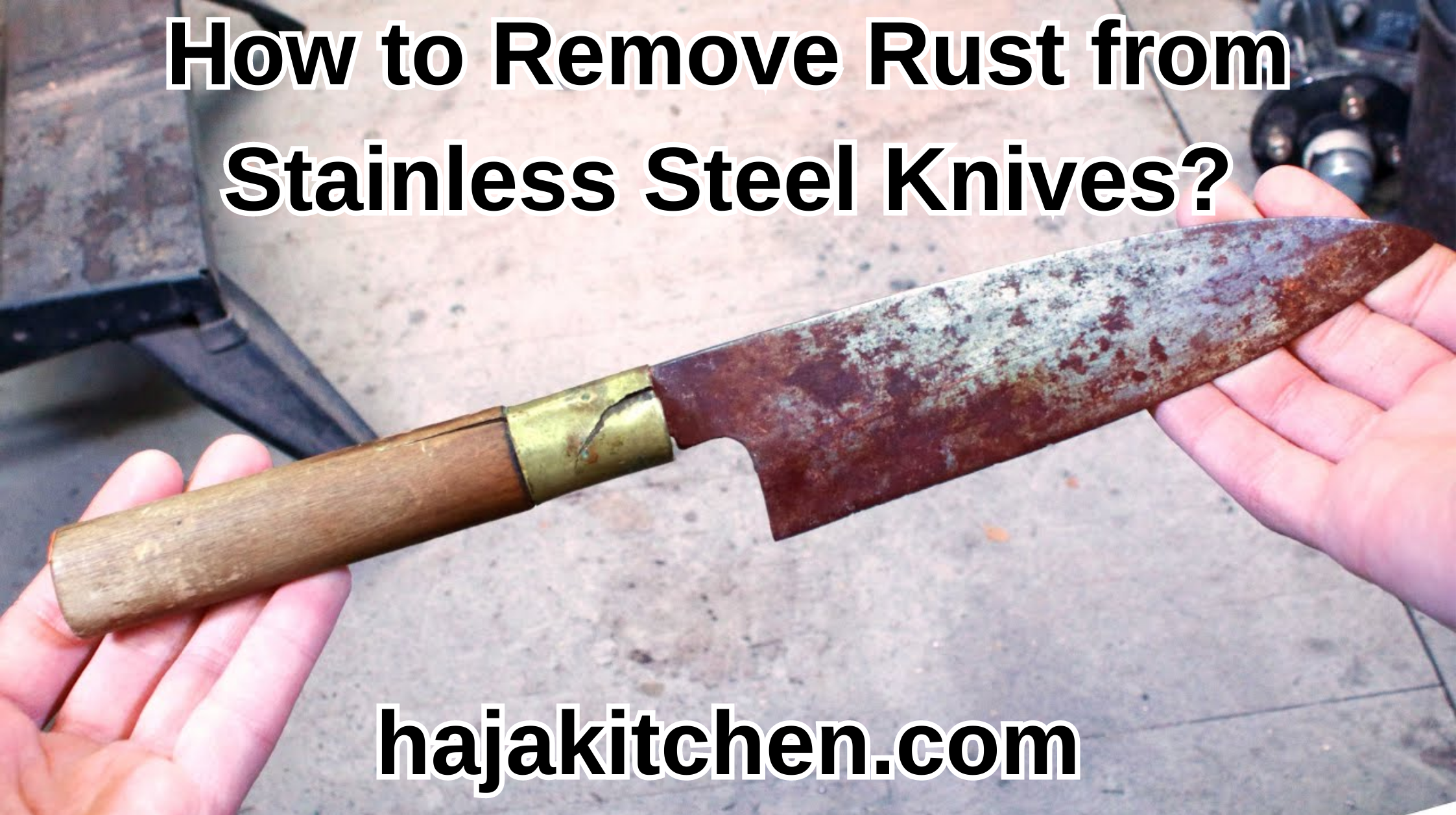Whether you’re a professional chef or just like to cook at home, having a good set of knives is essential. And if you have stainless steel knives, then keeping them rust-free is key. So, how do you remove rust from stainless steel knives? Luckily, there are a few different ways that you can try. Read on for tips on how to remove rust from stainless steel knives in no time.
The Dos And Don’ts Of Stainless Steel Knives

When it comes to taking care of stainless steel knives, there are a few things you should do and avoid. You should keep a few things in mind when it comes to the do’s and don’ts of the process when it comes to the do’s and don’ts:
DO
Keep your Knives clean and dry:
After each use, wash your knives with soap and water and dry them off with a clean cloth.
Store your knives in a dry place. If you’re not using your knives, make sure to store them in a dry place. This will help prevent rust from forming.
Use a Knife Sharpener Regularly:
A sharp knife is a safe knife, so make sure to use a knife sharpener on your stainless steel knives regularly.
DON’T
Use your Knives on hard surfaces:
Cutting on a hard surface can damage the blade of your knife and make it more likely to rust. Leave your knives in water. If you’re not using your knives, don’t leave them soaking in water. This will cause them to rust more quickly.
Use harsh cleaners on your Knives:
Harsh cleaners can damage the finish of your stainless steel knives, so it’s best to avoid them. With these dos and don’ts in mind, you can help keep your stainless steel knives in good condition for years to come.
How To Remove Rust From Stainless Steel Knives?

If your stainless steel knives have already started to rust, don’t worry. There are a few different ways that you can remove rust from your knives. Here are a few methods to try:
Baking Soda Paste
Create a thick paste by mixing baking soda with a small amount of water. Apply the paste to the rusty areas on the knife’s blade, let it sit for a few minutes, and then gently scrub the rust with a non-abrasive scrubbing pad or fine steel wool. Rinse the knife thoroughly and repeat if necessary.
Soak the Knives in vinegar
Vinegar is a natural rust remover, so you can use it to remove rust from your knives. Simply soak the knives in vinegar for a few hours, then rinse them off with water.
Use a Rust Eraser
A Rust Eraser is a specialized tool that you can use to remove rust from your knives. Simply rub the eraser over the rusty area of your knife until the rust comes off.
Lemon and Salt
Cut a lemon in half and dip it in salt. Use the lemon to scrub the rusty areas on the knife’s blade. The citric acid in the lemon and the abrasiveness of the salt can help remove the rust.
Potato and Baking Soda
Cut a potato in half and dip it in baking soda. Use the potato to scrub the rusted spots on the knife. The combination of the potato’s oxalic acid and the baking soda’s abrasiveness can be effective in rust removal.
WD-40
WD-40 can be used to loosen rust on stainless steel knives. Spray a small amount on the rusty areas, let it sit for a few minutes, then scrub the rust with a non-abrasive scrubbing pad or fine steel wool. Clean and dry the knife afterward.
Whichever method you choose, be sure to rinse and dry the knife thoroughly after removing the rust. After rust removal, it’s essential to apply a thin layer of mineral oil or food-grade oil to the knife’s blade and handle to protect it from future rusting. Regularly inspect your knives for rust and practice proper maintenance to keep them in excellent condition.
Techniques To Free Your Knives Of Rust

Once you have your tools, it’s time to focus on the techniques you’ll use to remove rust from your knives. Here are a few different methods that you can try:
The Soak Method
Soaking your knives in vinegar or another rust-removing solution is a great way to remove rust. Simply place your knives in a bowl or container and cover them with the solution. Let them soak for a few hours, then remove and rinse them off.
The Scrub Method
If the rust is hard to remove, you may need to scrub it off. You can use a stiff brush, steel wool, or a Rust Eraser to scrub the rust off of your knives. Just be sure to use gentle pressure so you don’t damage the blades.
The Polish Method
If you have stainless steel knives, you can polish them to remove rust. Simply rub a small amount of polish onto the rusty areas of your knives and buff it off. This will remove the rust and give your knives a shiny finish. With these methods in mind, you can remove rust from your knives quickly and easily. So, don’t let rust ruin your favorite knives – get rid of it with one of these methods.
Maintenance Is Key

Of course, the best way to remove rust from your knives is to prevent them from forming in the first place. Here are a few tips for preventing rust on your knives:
- Keep them clean and dry. After each use, wash your knives with soap and water and dry them off with a clean cloth.
- Store them in a dry place. If you’re not using your knives, make sure to store them in a dry place. This will help prevent rust from forming.
- Use a knife sharpener regularly. A sharp knife is a safe knife, so make sure to use a knife sharpener on your stainless steel knives regularly.
Conclusion
Rust can ruin your favorite knives, but it doesn’t have to. With these tips for removing rust from your knives, you can keep them looking like new. So, don’t let rust ruin your knives – get rid of it with one of these methods. Thanks for reading our blog.
FaQ
Q: How do I know if my stainless steel knife has rust?
To determine if your stainless steel knife has rust, you can perform a visual inspection and observe certain telltale signs. Here’s how to check for rust on your stainless steel knife:
• Examine the Blade: Inspect the entire surface of the knife blade, including the cutting edge, spine, and sides. Look for any discolored spots or areas that appear reddish-brown, orange, or dark in color. Rust typically appears as small patches or specks on the blade.
• Check the Cutting Edge: Pay particular attention to the cutting edge of the knife. Rust may develop first on the edge, especially if the knife is not properly dried after use or if it comes into contact with acidic foods.
• Look for Spots or Stains: Rust often appears as spots, stains, or tiny dots on the blade. These spots may be subtle, so inspect the blade under good lighting for a thorough examination.
• Rough or Uneven Surface: If you run your finger along the blade and feel any rough or uneven areas, it could indicate the presence of rust.
• Compare with Original Condition: If you’re familiar with the knife’s original appearance, compare it to how it looks now. Any changes in color or texture may indicate rust.
• Clean and Dry the Knife: Before inspecting for rust, make sure the knife is clean and dry. If the knife has been stored in a damp or humid environment, wipe it down and ensure it is completely dry before checking for rust.
Remember that stainless steel is resistant to rust but not entirely rust-proof, especially in harsh conditions or with extended exposure to moisture. Regularly inspecting your knives for rust is a good practice, and if you detect any signs of rust, it’s crucial to address the issue promptly. Proper maintenance, including thorough cleaning and drying after use, will help prevent rust formation and keep your stainless steel knife in excellent condition.
Q: Can rust damage the performance of my knife?
Yes, rust can significantly damage the performance of your knife. When iron in the steel reacts with moisture and oxygen, rust, or iron oxide forms on the blade. Rust creates irregularities and rough spots, leading to a dull edge. As a result, the knife struggles to cut efficiently, requiring more effort during food preparation.
The rough surface caused by rust also hampers the knife’s ability to glide smoothly through food, resulting in uneven cuts and a less precise cutting experience. If left untreated, rust can spread and corrode the blade, compromising its structural integrity and potentially causing irreparable damage. Continued exposure to rust weakens the blade, making it more susceptible to chipping or breaking, rendering the knife unsafe to use.
Rust also makes the knife more challenging to clean, trapping food particles and debris, leading to a less hygienic food preparation environment. Furthermore, rust particles can contaminate the food being prepared, posing health risks if consumed. The presence of rust can impart an unpleasant metallic taste to the food, negatively affecting the overall dining experience. In addition, a rusty knife is more likely to slip during use due to its rough surface, increasing the risk of accidents and injuries in the kitchen.
To maintain your knife’s optimal performance and longevity, it is essential to take preventive measures to avoid rust formation and promptly address any rust issues. Regular maintenance, proper cleaning, and suitable storage are crucial to protect your knife from rust and preserve its functionality. In case rust does occur, removing it correctly will restore the knife’s cutting performance and maintain its overall quality.
Q: Is it safe to use a rusty knife for food preparation?
Using a rusty knife for food preparation is unsafe and strongly discouraged. Rust on the knife’s blade poses several risks to both your health and the quality of the food. Rust is formed when iron in the steel reacts with moisture and oxygen, resulting in iron oxide, which is not suitable for consumption. When you use a rusty knife, the rust particles can contaminate the food, causing gastrointestinal discomfort.
Moreover, rust imparts an unpleasant metallic taste to the food, making it unappetizing. Ingesting rust can irritate the digestive system and lead to health issues.
Additionally, a rusty knife’s cutting performance is compromised, resulting in uneven cuts and increased effort during food preparation. Safety is also a concern as a rusty knife is more prone to slipping, increasing the risk of accidents and injuries.
Q: What are the risks of not removing rust from my knife?
Failing to remove rust from your knife can have significant consequences, impacting its performance, durability, and even your safety in the kitchen. A rusty blade leads to irregularities and reduces cutting efficiency, making food preparation more challenging.
Moreover, the edge becomes dull, increasing the risk of accidents during slicing. If left untreated, rust can spread and corrode the blade, weakening its structure. This could lead to irreparable damage, necessitating a replacement. Rust particles can contaminate food, posing health risks.
Additionally, cleaning becomes difficult as rust creates rough surfaces, trapping debris. Consuming rust-contaminated food can cause gastrointestinal discomfort. Prolonged exposure to rust can cause irreversible damage, affecting the knife’s original condition.
Q: How often should I check my knives for rust?
The frequency of checking your knives for rust depends on several factors, including the type of environment they are stored in and how often you use and clean them. As a general guideline, it is advisable to check your knives for rust regularly, ideally every few weeks or at least once a month. However, certain conditions may warrant more frequent checks. Here are some considerations:
• Humid Environments: If you live in a humid climate or store your knives in a damp area, rust can develop more quickly. In such cases, it’s essential to check your knives more frequently, perhaps once a week.
• Frequency of Use: Knives that are used daily or frequently are more susceptible to exposure to moisture and food acids, which can accelerate rust formation. Check these knives more often, possibly every week or after every use.
• Storing Knives Properly: If you store your knives in a knife block, magnetic strip, or on a magnetic rack, they are more exposed to air circulation, making it easier to spot rust. On the other hand, knives stored in closed drawers or knife rolls may need more intentional checks.
• Care and Cleaning Routine: Regularly cleaning and drying your knives after use can help prevent rust. If you tend to leave your knives wet or use them for cutting acidic foods without proper cleaning, checking for rust more frequently is essential.
• Blade Material: Different stainless steel alloys have varying rust resistance properties. Some may be more prone to rusting, so it’s a good idea to check knives with specific blade materials more frequently.
By making a habit of checking your knives regularly, you can catch any signs of rust early on, preventing it from becoming a more serious issue. It’s essential to address rust promptly to avoid further damage to the knife’s blade and maintain its performance and longevity. Additionally, routine checks also provide an opportunity to assess the overall condition of your knives, ensuring they remain in excellent working condition for safe and efficient food preparation.
Q: What are the signs that my knife needs professional attention for rust removal?
While minor rust on a knife can often be addressed at home, certain signs indicate that your knife may require professional attention for rust removal. When you notice any of the following signs, it’s best to seek the assistance of a professional knife sharpener or cutlery expert:
• Severe Pitting: If the rust has caused extensive pitting or deep grooves on the knife’s blade, it may be challenging to remove the rust effectively without affecting the blade’s integrity. Professional sharpeners have the expertise and equipment to assess and restore severely damaged blades.
• Dull or Blunted Edge: Rust can deteriorate the edge of the knife, resulting in a dull or blunted cutting edge. A professional can not only remove the rust but also re-establish a sharp edge through proper sharpening techniques.
• Complex Blade Designs: Knives with intricate or specialty blade designs, such as Damascus patterns or unique grinds, require careful attention during rust removal to preserve their aesthetic appeal. Professionals are skilled in handling such blades.
• High-Quality Knives: If you own high-quality or expensive knives, seeking professional assistance ensures that the rust removal process is done with precision, preventing any potential damage to the blade.
• Rust in Handle or Rivets: Rust that has extended beyond the blade and affects the knife’s handle, bolster, or rivets may require specialized cleaning and restoration, which a professional can handle effectively.
• Custom or Vintage Knives: Custom or vintage knives may have unique materials or finishes that require special care during rust removal. Professionals with experience in handling such knives can provide the necessary expertise.
• Collectible Knives: For collectible knives, it’s best to consult an expert who understands the value and importance of preserving the knife’s original condition.
• Multiple Knives or Extensive Rust: If you have multiple knives with rust issues or if the rust problem is widespread, a professional service can efficiently address all the knives and restore them to their best condition.


